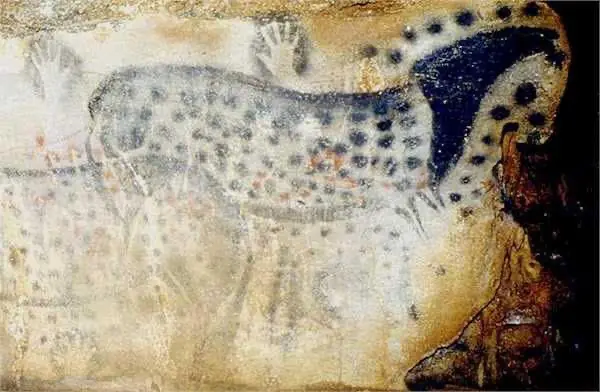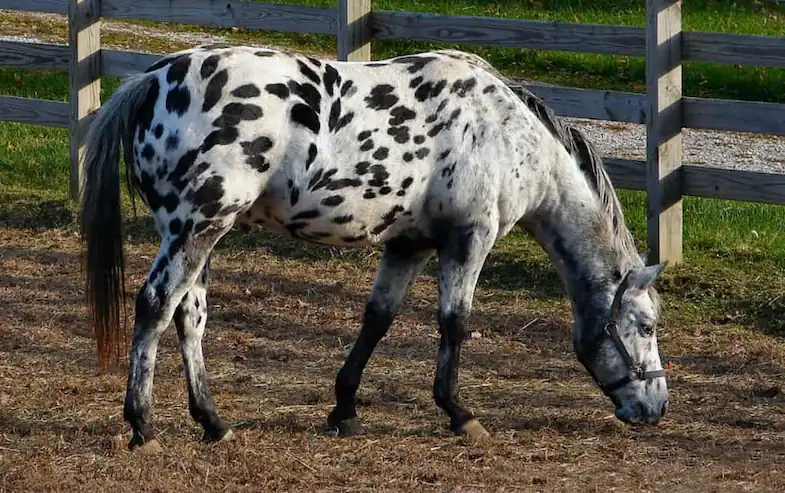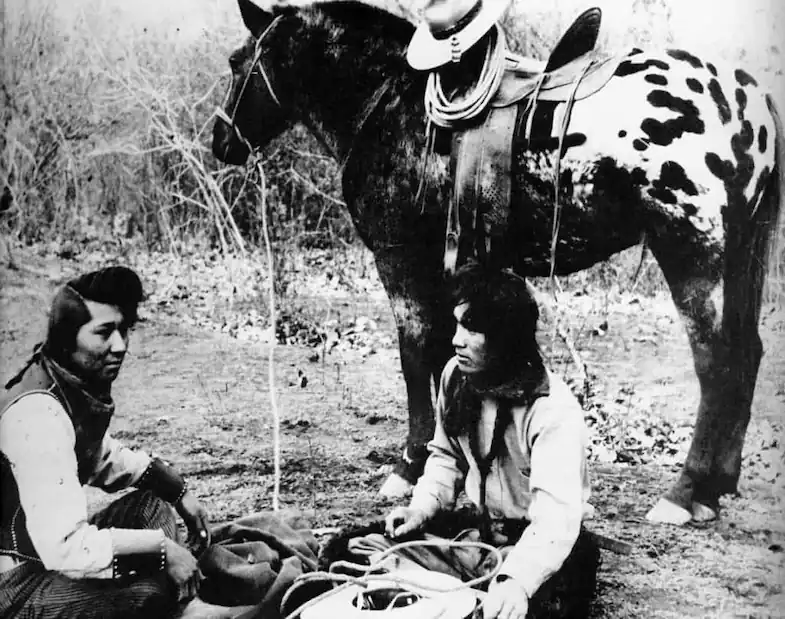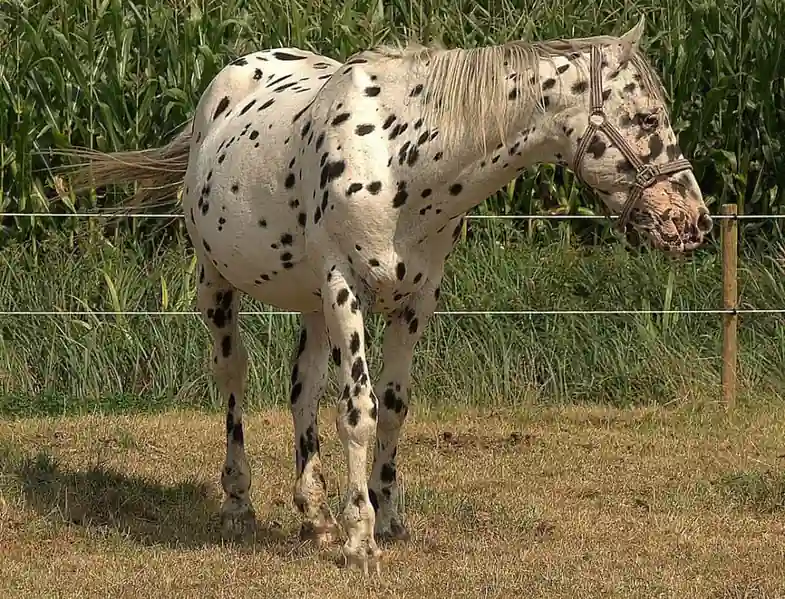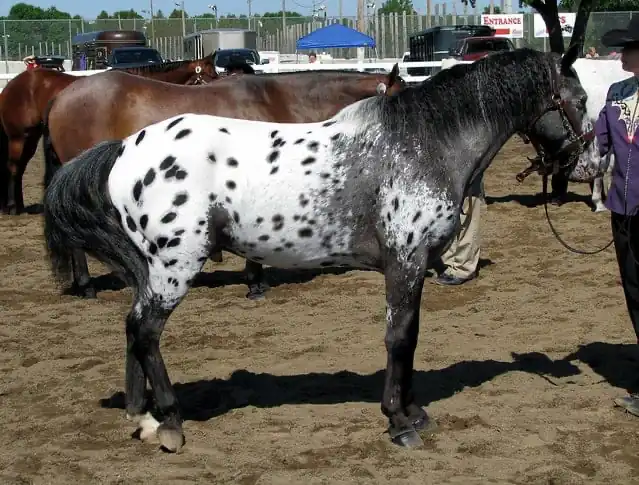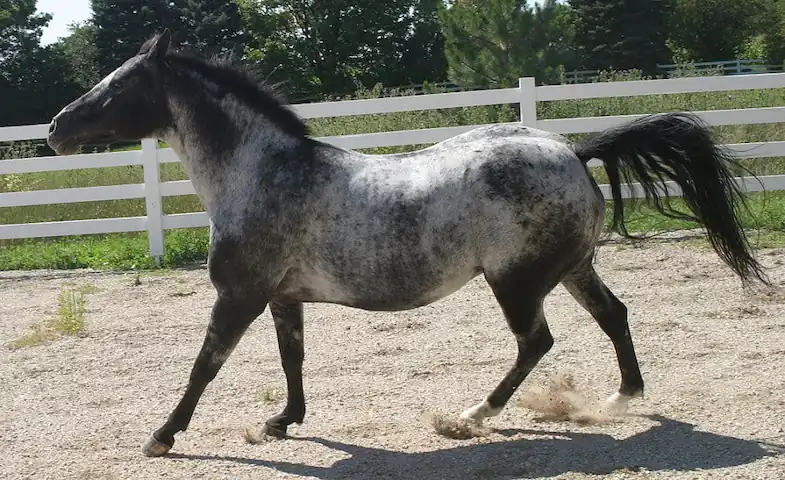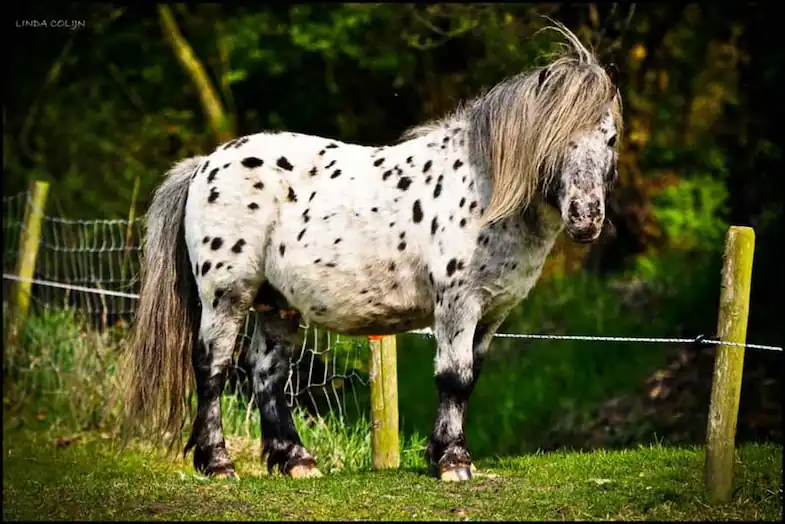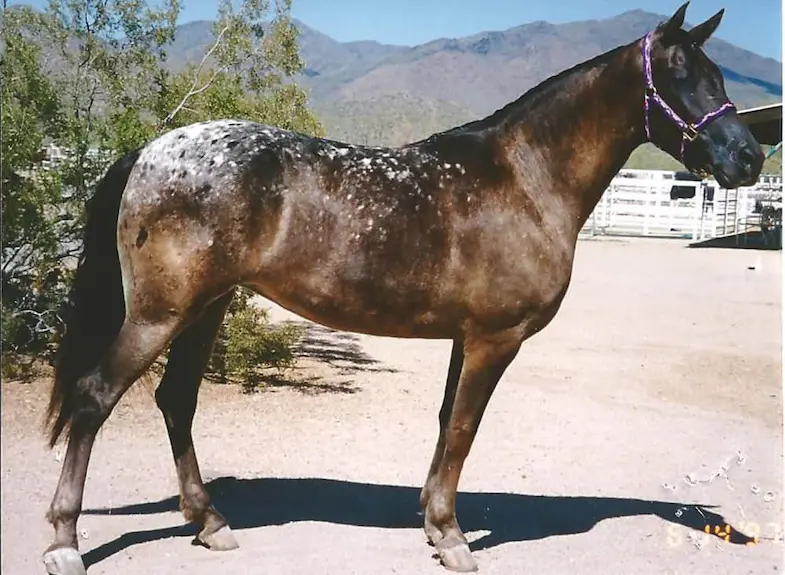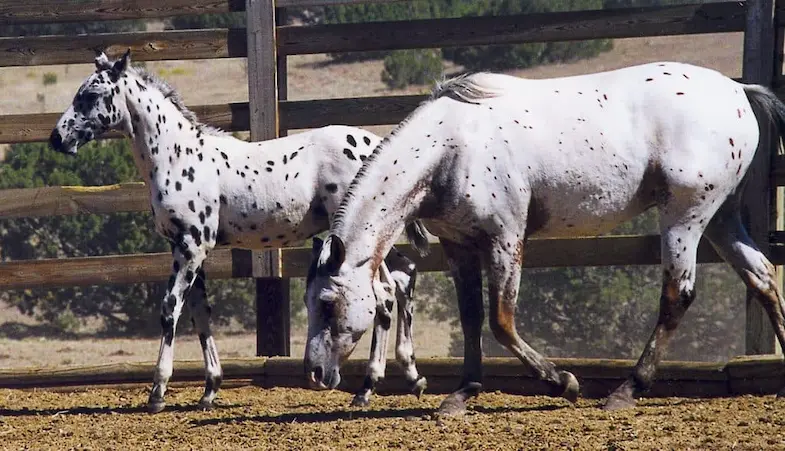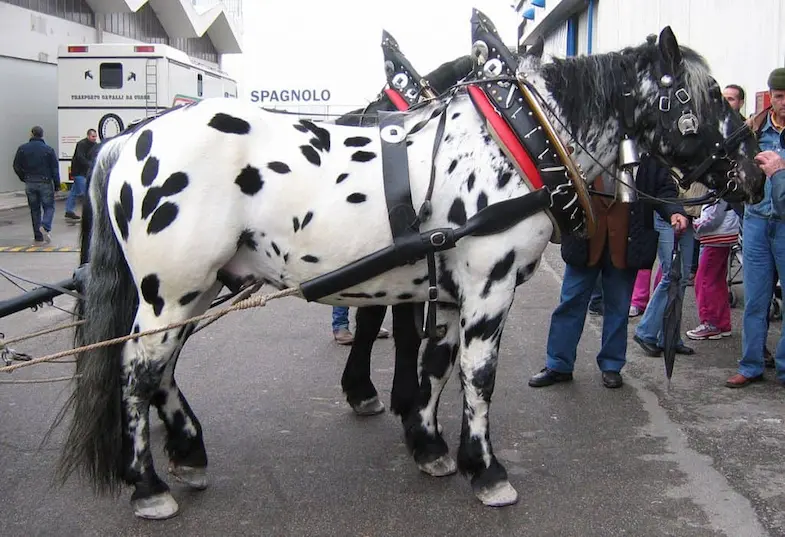You might think that the spotted coat pattern is relatively new but these distinctive markings were so highly prized amongst ancient man that they adorned cave walls with paintings of them. Lascaux cave complex in southern France (which is around 17,000 years old) is probably the most famous of these.
While the popularity of spotted horses began to fall out of favor a few hundred years ago, today they’re much sought after again. This resurgence in popularity has meant that today many breeds (such as the Quarter Horse) allow the spotted coat pattern within the registry. There are also a number of breeds that are predominately spotted and it’s those that I’ve decided to focus on within this article.
Spotted coat patterns
When it comes to the spotted coat pattern there’s a variety of different patterns and characteristics. You may also be surprised to know that, while not in the case of every horse, you can feel a horse’s spots. The hair is a slightly different length so, if you run your hand over them, you can actually feel each of the different spots.
- Leopard – Probably the most famous and easily recognizable coat pattern, horses displaying this pattern have a pure white base coat with dark spots over the whole body, including the head and legs. Their spots don’t change at all throughout their lives. Sometimes this pattern is known as full leopard.
- Near Leopard – Horses with this pattern have a white body with dark spots but their head and legs (and sometimes part of their body) have a different color. As the horse ages, the darker color normally fades and the horse looks like a full leopard.
- FewSpot Leopard – Like both the full leopard and near leopard, these horses are born with a white base coat. They differ though because they only have a few spots but also normally have a roan color too which fades with age.
- Near FewSpot – The only difference between the near fewspot and true fewspot horses is that the head, neck, and legs of the near fewspot are a very noticeably darker color, as opposed to the roan of a true fewspot.
- Spotted Blanket – The body color of a horse with a spotted blanket is a solid dark color that covers their head, legs, and most of the body. They also have a white area, that extends from their back over the rump and towards their legs, which contains spots that typically match the body color.
- White Blanket – Sometimes called snowcap blanket, this is similar to the spotted blanket in every way except for the fact that horses with this coat pattern either have no spots or very few.
- Frosted Blanket – Also known as frosted hip, horses with this coat pattern have a dark body color but will have white spots (often giving the appearance of frosting) over their loins and hips.
- Snowflake – Horses with this coat pattern will typically have a dark coat that covers their whole body with white spots, giving the impression of snowflakes. A lot of snowflake horses are born with solid coats that ‘color out’ with age, sometimes becoming roan.
- Marble – Marble horses are either red or blue roan and have darker ‘vanish’ marks over their body.
- Solid – Because the spotted coat pattern is controlled by a genetic mechanism (known as the leopard complex gene) it may not show in every horse that carries it, this is why many spotted breeds allowed solid-colored horses to be registered, providing they have other characteristics such as:
- Mottled skin – Sometimes referred to as parti-colored skin or marbled skin, this involves patches (or mottling) of pink and black skin. While the horse will have it over his entire body it’s more noticeable on areas where there’s no hair or the hair is thinner, ie around the eyes, muzzle, and genitals.
- White sclera – Often called a human eye, the area around the eye (known as a sclera) in most horses is dark but in spotted horses its white which makes it look a little bit like ours, hence the name human eye.
- Striped hooves – The hooves of spotted horses tend to have vertical lines (or stripes) in them, although this isn’t the case with all solid colored spotted horses.
Appaloosa
Height: Typically anything between 14hh (56 inches) and 16hh (64 inches).
Color: Any color base coat overlaid with spots in a variety of patterns (see above).
Country of Origin: USA
Character: The Appaloosa is an all-round great horse that has plenty of stamina, it’s also extremely versatile. They have kind natures and are highly intelligent.
Interesting fact: The Appaloosa is immensely popular and can count mainly celebrity owners amongst its fans. Sir Paul McCartney, Richard Gere, Loretta Lynn, and Burt Reynolds are just some of the famous Appaloosa owners.
Without a doubt, the Appaloosa is the most famous (and most popular) of all spotted breeds but it wasn’t always the case. As recent as the 1930s the breed was facing being lost completely and its success today is thanks mainly to the efforts of one man, Claude Thompson, who had a spotted colt as a child and dreamed of having a herd of them one day.
You might wonder where the name Appaloosa comes from but it’s actually a corruption of the Palouse region of north-western America. Originally lovingly referred to ‘a Palousey’ horse, it wasn’t until 1938 that the name changed to Appaloosa.
Nez Percé Horse
Height: As a rule anything between 15hh (60 inches) and 16hh (64 inches).
Color: Most horses will be buckskin or palomino with a spotted coat pattern and characteristics.
Country of Origin: USA
Character: The Nez Percé Horse is a gentle quiet breed that can easily be handled by children. It also has phenomenal endurance, is highly intelligent, and is eager to please.
Interesting fact: The original Nez Percé Horse, which also formed the basis for the Appaloosa was almost wiped out completely by the US Army in 1877. At the end of the Nez Percé war, the tribe wasn’t allowed to own more than a few horses and were banned from breeding them.
You might be forgiven for thinking that the Nez Percé Horse is actually just a colloquial name for the Appaloosa but it is, in fact, a breed in its own right and is the result of a breeding program established by the Nez Percé tribe, the First Nations Development Institute, and the United States Department of Health and Human Services. The program began in 1995 and crosses foundation Appaloosas from the Wallowa herd (the region the tribe originally bred these horses) with Akhal-Tekés.
While the breed is of course similar to the Appaloosa and as such can be registered as one its conformation is very different. The Appaloosa, which has a lot of Quarter Horse blood, is a more stocky horse while the Nez Percé Horse on the other hand is leaner and more refined. While not all of them, most Nez Percé Horses are also gaited.
Knabstrupper
Height: While they can be less than 14.2hh (56 inches) most will stand somewhere between 15.2hh (61 inches) and 16hh (64 inches).
Color: Any color base coat with spots in any of the patterns mentioned above.
Country of Origin: Denmark
Character: Knabstruppers are gentle horses that are known for their friendly temperament. They’re also extremely intelligent horses.
Interesting fact: The name Knabstrupper comes from the estate of the breeds founder Judge Lunn which was known as Knabstrup, some people even refer to the breed as that (ie without the ‘per’ on the end).
While the Knabstrupper (which is pronounced Kah-nob-strooper) was founded by a Spanish mare called Flaebenhoppen (and a Frederiksborg stallion) in 1808, its origins go as far back as the Viking era. Breeding horses for speed and endurance it’s believed that their spotted coat pattern came from the Chinese who, in the early 1100s, began trading with the Europeans. The Chinese, who were known for using spotted horses for transport, used Denmark as the main route to France and Spain.
The Knabstrupper is very popular in Denmark as a carriage horse but also at ‘nostalgia’ shows where riders dress up in traditional Danish dress. Sadly in the past unscrupulous breeding meant that the breed had been classed as rare, but thanks to the use of Appaloosa blood its future is now much more secure. The introduction of Appaloosa blood has also increased the original height of 14.3hh (57 inches).
Pony of the Americas
Height: The average height is between 11.2hh (46 inches) and 14hh (56 inches).
Color: Spotted
Country of Origin: USA
Character: The Pony of the Americas has the speed and stamina of the Appaloosa as well as the courage and determination of the Shetland Pony.
Interesting fact: While adults and children can both ride these ponies only children are allowed to do so in the show ring, adults must either show them in halter classes or driving.
The Pony of the Americas (or POA) is an unusual breed in that its creation wasn’t the result of an idea to create a breed for a particular purpose, instead, its existence was a complete accident. It happened when a Shetland Pony breeder, called Les Boomhower, was offered an Appaloosa mare who was in foal after having been ‘accidentally’ bred with a Shetland Pony. The resulting colt, called Black Hand because of the spots on his rump, was ideal for older children who were too big for smaller ponies but too small for horses. This inspired Boomhower to create the POA as an ‘in-between’ Western utility breed.
In an effort to increase the height, the Shetland pony was dropped from the breeding program in favor of Welsh Mountain Ponies, Arabians, Appaloosas, and Quarter Horses. This decision proved popular and not only saw the height increase but also the strength of the breed. Today they’re taller but are also more than capable of carrying adults as well as children.
Colorado Ranger
Height: Like the Appaloosa, the Colorado Ranger can stand between 14hh (56 inches) and 16hh (64 inches).
Color: Any color is allowed but spotted horses are by far the most common (and most popular).
Country of Origin: USA
Character: The Colorado Ranger is an extremely intelligent horse that is prized for its cow sense, energy, and friendly nature.
Interesting fact: The Colorado Ranger can be dual registered with the Appaloosa Horse Club and around 90% of them are, but an Appaloosa can only be registered with the Colorado Ranger Horse Association if they have the right bloodlines.
Taking its name from the Colorado High Plains where it originated, the breed was founded by the 18th US President, General Ulysses Grant. In 1878 he was given two stallions (Leopard and Linden Tree) by Abdul Hamid II (the 34th Sultan of the Ottoman Empire), these horses were, at one point, leased to General Colby who bred high-quality ranch horses from them. One of the stallions (a grandson of Leopard on both sides) that Colby bred was purchased by a group of Colorado ranch owners who used him to improve their stock. He sired two horses, Patches #1 and Max #2 who are the founding sires of the breed, and all horses today can trace back to either of them.
While the official name of the breed is Colorado Ranger, people lovingly refer to them a Colorado Rangerbreds. After all, they were purposely bred for life on the ranch so, to some extent, it sums the breed up nicely.
British Spotted Pony
Height: There are three types of pony, the miniature pony must be under 10.3hh (42 inches) while the riding and cob type can stand up to 14.2hh (57 inches).
Color: All ponies have a spotted coat that can be any of the varieties mentioned above but leopard is the most common.
Country of Origin: United Kingdom
Character: These little ponies are bold and courageous, they’re intelligent and friendly and make great first ponies for children.
Interesting fact: Having once lived in a feral state in the British Isles its spotted coat pattern provided a very useful natural camouflage amongst the heaths and forests that covered the area at the time.
While it may not be as well known as other spotted breeds such as the Appaloosa or Pony of the Americas, the British Spotted Pony has been around for many thousands of years and is in fact descended from the spotted horses that are depicted on the cave in southern France.
These plucky little ponies were once loved by many Royal families throughout Europe who would often gift them to each other. Since then their popularity has grown outside of Britain and during the 1960s and 1970s, so many were exported to other continents that they became rare in their native homeland. Today, thankfully, this isn’t the case and the British Spotted Pony Society has done a lot to increase their numbers.
Walkaloosa
Height: Any height between 13hh (52 inches) and 16hh (64 inches) is allowed but 14hh (56 inches) to 15.2hh (61 inches) is preferred.
Color: Bay with any spotted pattern is the most common.
Country of Origin: USA
Character: The Walkaloosa has a friendly, kind nature and is willing to please. They’re quiet horses that are very giving.
Interesting fact: The Walkaloosa Horse Association was co-founded by the same Claude Thompson that saved the Appaloosa from extinction.
Some people may argue that the Walkaloosa is nothing more than a colored type and not a breed at all but this couldn’t be more wrong. Yes, it’s colored but it’s actually a specific breed with its own registry and breed standards. A lot of Walkaloosas have Appaloosa pedigree but they are all gaited and perform a four-beat lateral gait that, known as the Indian Shuffle, is unique to the breed. The gait, which involves each foot moving separately, is said to be extremely comfortable and almost feels like you’re floating.
It is believed that the Walkaloosa was developed by crossing Appaloosas with gaited breeds such as the Paso Fino, Peruvian Paso, and the Missouri Fox Trotter. Even today Appaloosa and gaited horse crosses are allowed to be registered, although this isn’t as common as it used to be.
Tiger Horse
Height: Most horses stand between 14hh (56 inches) and 15.2hh (61 inches) but anything between 13hh (52 inches) and 16hh (64 inches) is allowed.
Color: Any base color with a spotted coat pattern and other ‘spotted’ characteristics.
Country of Origin: USA
Character: The Tiger Horse has a gentle nature, they’re very loving horses that are also known for their sensibility and intelligence.
Interesting fact: The name Tiger Horse is a direct translation from the Spanish El Caballo Tigre. The Spanish had no word for leopard so they called leopard spots (or leopard markings) tiger markings.
Originating from the Asian Steppes and, in particular, the Don area of Russia, the Tiger Horse is descended from the ancient Soulon horse that was bred in China during the Tang Dynasty around 1400 years ago.
All Tiger Horses are registered in one of three different categories depending on their color and their genes.
- Ghost – This is for white horses that are homozygous which means they will always produce a colored foal – even if bred to a solid colored horse. They will also pass the leopard complex gene to their offspring.
- Leopard – This is for true leopard-spotted horses.
- Roan – As you might guess this is for horses that have a roan coat coloring.
Noriker
Height: Typically most horses will stand between 16hh (56 inches) and 17hh (68 inches).
Color: Today only around 10% of all Norikers have a spotted coat but in the past most of them did. Other colors include bay, chestnut, and black.
Country of Origin: Austria
Character: The Noriker is an extremely strong horse that has a great temperament. They’re often thought of as being willing horses that are easily handled by both children and adults.
Interesting fact: Male horses are more likely than female horses to be spotted, their spots are also generally bigger than those of female horses.
Also known as the Norico-Pinzgauer, the Noriker is the only heavy horse breed that has the leopard complex genetic mechanism and takes its name from the Roman province of Noricum (most of which is now in modern-day Austria) where it was originally bred. Having been originally bred in and around the Austrian Alps, the Noriker is more than happy to live at high altitudes. In fact, they’re perfectly adapted to thrive as high as 6000 feet (1829 meters).
While the breed is more commonly linked to the Roman Empire, its roots can actually be traced back around three thousand years to 600BC. A recent archaeological dig has found that the ancient Celts (who lived in most of Europe at that time) bred alpine horses. These horses were bred with Roman horses at around 3BC to create the Noriker.
Further reading
If you enjoyed this then you might be interested in these other breed articles:
- Best breeds for trail riding
- Best breeds for barrel racing
- Best breeds for dressage
- Best breeds for eventing
- Best breeds for jumping
- Best breeds for new riders
- Best breeds for racing
- Most unusual breeds in the world
I hope you found this article helpful. If you did I’d be grateful if you could share it please as it would really help me.
Recommended products
Over the years I have tried hundreds of different horsey products, from various blankets and halters to different treats. Some I’ve loved, others I’ve hated but I thought I’d share with you my top all-time favorite products, the ones I never leave the yard without. I’ve included links to the products (which are in no particular order) that I really think are great.
- Horse Knots by Reference Ready – If you’re like me and enjoy pocket reference guides then you’ll love this knot tying guide. These handy cards can easily fit in your pocket or attach to the saddle for quick reference. They’re waterproof, durable and are color coded to make them easy to follow.
- Mane ’n Tail Detangler – Even if you never show your horse you’ll need to detangle his tail from time to time (and possibly his mane too) which is always a challenging chore! I’ve found that if I run a little bit of detangler through my horse’s tails every few days it stops them from getting matted up and makes combing them easy, even if they’re coated in mud. I don’t know if I should admit to this or not but it also works wonders on my hair.
- TAKEKIT Pro clippers – Over the years I’ve tried a lot of different clippers and while some were obviously better than others I found these to be by far the best. They are heavier than a lot of other clippers but for me, that’s a good thing, it makes them feel more sturdy and hardwearing. On top of that they have a range of speeds so are just as good for clipping your horse’s back as they are his face. I also like the fact that they come in a handy carry case but that’s not for everybody. The company that makes them is super good and incredibly helpful too, a real bonus these days. The only thing I wasn’t keen on was the fact that it doesn’t come with any oil, but that’s not a major problem as it’s not difficult to buy lubricant.
- Shire’s ball feeder – There are so many boredom buster toys out there but I like to use these every day, regardless of whether or not my horses are bored. I find that it helps to encourage my horses to problem solve by rewarding them with treats (or pieces of fruit) but it also mimics their natural grazing behavior which helps to keep them calm and de-stressed.
- Horse safe mirror – This is a strange one that many people are surprised about but I like to put horse safe mirrors in the trailers as well as in the quarantine stalls. It helps to prevent the feeling of isolation by giving the impression of other horses being around. Being herd animals horses can get extremely stressed when they feel that they’re on their own but with these stick-on mirrors, they believe that at least one other horse is with them.
- Rectal thermometer – I know this isn’t glamourous at all but it’s vital for your horse’s well-being to be able to check their temperature and a rectal thermometer is the easiest way of doing this which is why I’ve added it to the list.
Shopping lists
I’ve also put together a few shopping lists of essential items that I’ve found helpful over the years. I’ve broken the lists down into different categories rather than put everything in one massive list 😉

